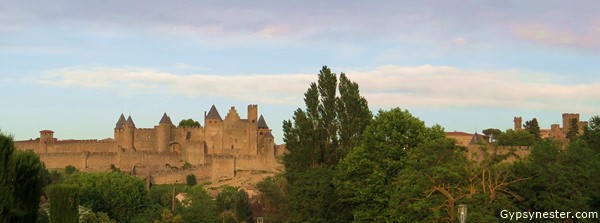
With all of the traveling we’ve done over the past decade or so, sometimes we worry a bit about becoming jaded. Like we might have seen it all and there is nothing new under the sun.
Then we stumble upon someplace like Carcassonne and it’s like a bell rings in our heads. This moderately sized outpost in the southwest of France proved to us that there are still gems left to be discovered.
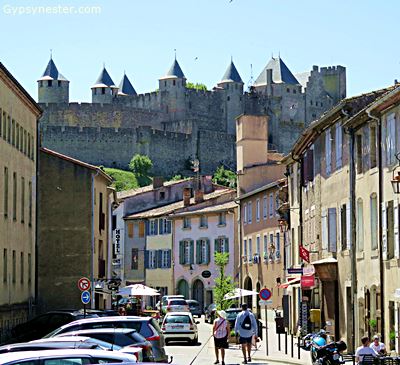 It was a quirk of fate, we never would have known about this amazing city if not for France Cruises inviting us to explore the Canal du Midi with them on the luxury barge Clair de Lune. Carcassonne was one of the pick-up spots to begin our cruise, and when we looked into it we knew we needed to arrive a couple days early.
It was a quirk of fate, we never would have known about this amazing city if not for France Cruises inviting us to explore the Canal du Midi with them on the luxury barge Clair de Lune. Carcassonne was one of the pick-up spots to begin our cruise, and when we looked into it we knew we needed to arrive a couple days early.
Our thinking was two-fold. One, we could have some time to overcome the ten time zones of jet-lag that had scrambling our internal clocks and two, we could spend a little more time in town than the visit that was included in our tour.
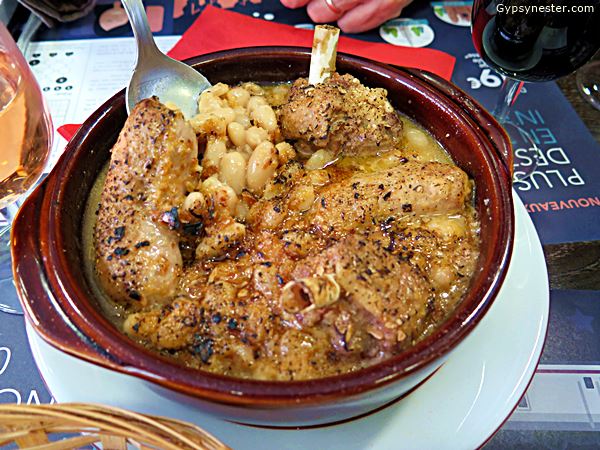 To celebrate our fortunate discovery we feasted on the area’s most famous dish, cassoulet, made with beans, sausage and duck. We hear it cures jet-lag!
To celebrate our fortunate discovery we feasted on the area’s most famous dish, cassoulet, made with beans, sausage and duck. We hear it cures jet-lag!
We then set out to climb up to the walled old city, Cité de Carcassonne. The location has been an important trade spot, beginning with the Celts and Gauls, for at least five thousand years and used as a fortress for more than two thousand of those.
The Romans built the original fortifications a century before Christ. Unlike many other places, those structures are not in ruins because the subsequent builders chose to add on to the ramparts rather than replace them.
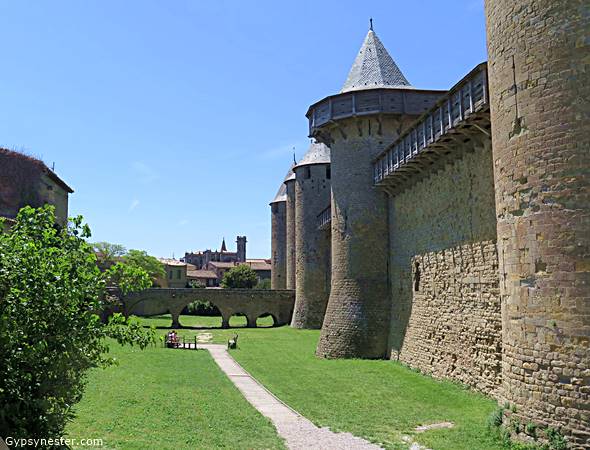
Much of this additional construction came under the Visigoths, who took the city around the year 453. They were followed by the Saracens from 725 until King Pépin the Short (Pépin le Bref) King of the Franks drove them away in 759.
After that the city was ruled by a series of nearby viscounts from Albi and Nîmes, Barcelona, or of Toulouse. Finally, in 1247, they submitted to the rule of the kingdom of France and the constant changing of the guards came to an end.
At the main entrance, the Porte Narbonnaise, we met Lady Carcass, or at least her stone likeness, and learned the story of how the city got its name. Like any good legend, the facts may be somewhat suspect.
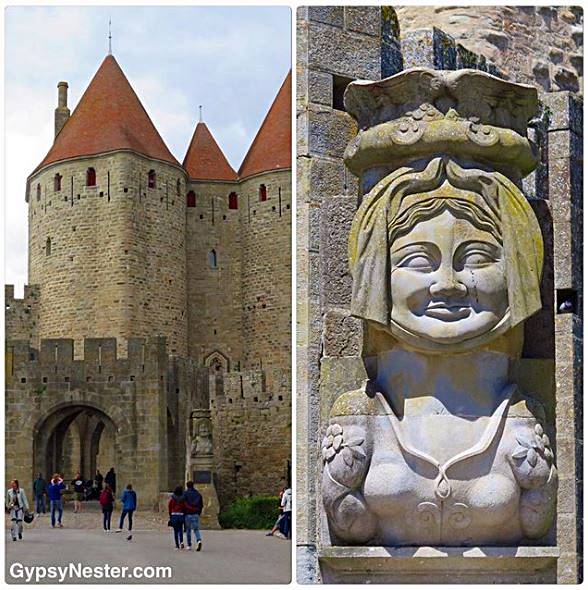
The tale is told that the Franks led by Pépin (the much less than tall) laid siege on the fortifications and after some time (the stories varied from a month to several years depending on who was doing the telling) Lady Carcass, the ruler during the Saracens stay, asked for an accounting of their supplies.
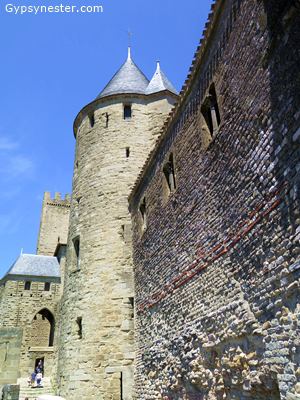 All that remained was a pig and one bag of wheat. The Lady hatched a plan and ordered the wheat fed to the pig and then the pig thrown from the highest tower. Could this be the origin of the phrase when pigs fly?
All that remained was a pig and one bag of wheat. The Lady hatched a plan and ordered the wheat fed to the pig and then the pig thrown from the highest tower. Could this be the origin of the phrase when pigs fly?
Anyway, upon seeing this spectacle the Franks surmised that the besieged Saracens must have had plenty of food left to survive the siege so the invading army left. As they rode away Lady Carcass ordered all of the bells to be rung.
Hearing the clamor Pépin looked back and declared “Carcass sonne!” meaning Carcass rings.
One fact that is not up for debate is the impressive fortifications being one of Europe’s finest and largest. The massive structure was once home to thousands of people and contains 52 towers surrounded by two miles of walls.
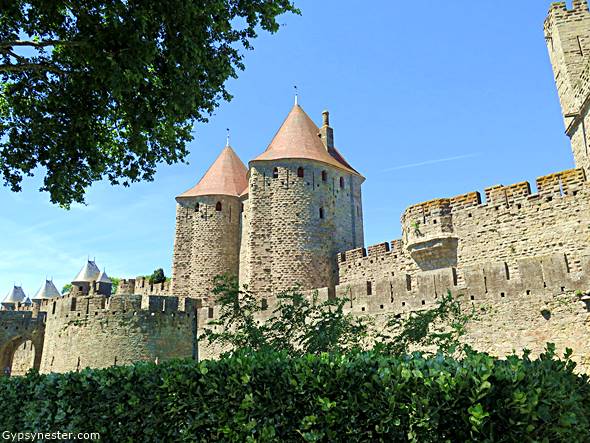
We wandered through the town within those bulwarks, but that jet-lag we mentioned was getting the better of us so we made our way back down secure in the knowledge that we would return in a few days on our barge tour.

The next day we dedicated to exploring the lower town, since we knew it would not be included in our cruise. This settlement was founded in 1247 below the castle and has grown into a fairly large city of about 50,000.
As with many European towns, the oldest part is enclosed within medieval walls. The Bastide Saint Louis began as protective moats, then towers were added on the corners (three of which are still standing), and finally a complete wall.
 After a walk through the morning market in the main square, we headed for Saint Vincent’s for what everyone described as the best view anywhere in town.
After a walk through the morning market in the main square, we headed for Saint Vincent’s for what everyone described as the best view anywhere in town.
This fifteenth century church is famous for an octagonal bell tower, the highest around, which provides access to the top for anyone willing to climb the spiral stone staircase of 232 steps. A surprise awaited about a third of the way up when we found a little room, once used as a jail, with a window that overlooked the interior of the church.
That was a welcome rest on our ascent, but we can safely say that the magnificent 360 degree vista at the summit was well worth our burning leg muscles.
Back down on solid ground, we walked through the Portail des Jacobins and right into another street market just outside of the south wall. Following along to the end of that wall, we came upon a hidden treasure that was not marked on any of our maps, the Jardin du Calvaire or Calvary Garden.
Contained within the Bastion les Moulins on the southwest corner of the city wall, this garden is a walk through the Stations of the Cross that culminates at a full-sized crucifixion scene of Jesus and the two others on either side on top of a small hill. Mary stands below the gruesome and shockingly lifelike scene.

In 1825 Canon Cazaintre, who is now buried on the site, formed a group to create the garden and hired architect Jean-François Champagne for the job. Unfortunately it has fallen into some disrepair, however, for us that added to the dark and surreal quality of the setting.
When we returned to Carcassonne after boarding the Clair de Lune we spent another afternoon up within the ancient fortifications of Cité de Carcassonne. This time we had a guide, so we learned much more about the construction and history of the remarkable site.
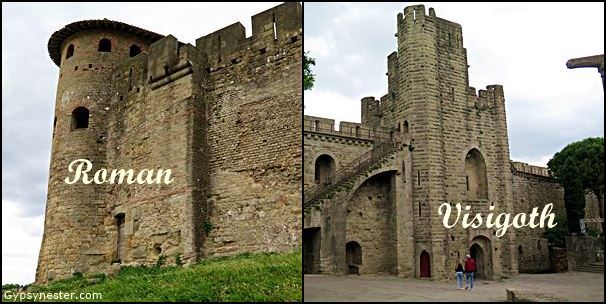
Under Antoine’s guidance we got so we could identify the different structural styles of the various occupants who built here over the centuries. He pointed out the arches and bricks of the Romans, the more intricate stone work of the Visigoths, and the various more modern wooden works inside the ramparts.
Having spent three days walking over five thousand years of history, it was no wonder our heads were ringing like Lady Carcass’ bells.
Little did we this was only the beginning of an amazing adventure.
David & Veronica, GypsyNester.com
See all of our previous adventures in France!
A big thank you to France Cruises for helping with this adventure, as always, all opinions are our own.


